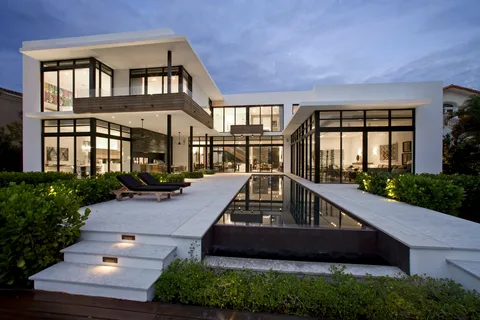Modern house design has emerged as one of the most popular architectural styles in today’s real estate and home improvement market. Characterized by clean lines, open spaces, and a minimalist aesthetic, modern house design offer a unique blend of functionality, sustainability, and visual appeal. Whether you’re planning to build a new home or renovate your existing one, understanding the principles of modern house design can help you create a space that is both stylish and practical.
What Is Modern House Design?
Modern house design refers to architectural styles that emphasize simplicity, clean geometry, and the use of modern materials such as steel, glass, and concrete. This design philosophy gained popularity in the early to mid-20th century and continues to influence home construction and interior design today. Unlike traditional homes with ornate details and segmented rooms, modern homes often feature open floor plans, flat or low-pitched roofs, and large windows that invite natural light into the space.
Key Features of Modern House Design
1. Open Floor Plans
One of the most defining features of modern house design is the open floor plan. Walls between the kitchen, dining, and living areas are minimized to create a sense of spaciousness. This layout not only enhances the flow of natural light but also encourages social interaction, making it perfect for families and entertaining guests.
2. Natural Light and Large Windows
Modern homes are designed to bring the outside in. Large, floor-to-ceiling windows are a staple in modern house design, allowing for an abundance of natural light and unobstructed views. Skylights and glass doors also contribute to a bright and airy atmosphere.
3. Minimalist Aesthetic
Modern house design embraces the principle of “less is more.” It avoids excessive decoration and clutter, instead focusing on clean lines and functional furnishings. Color schemes are typically neutral, with white, grey, and black being common choices. Accent colors can be added through artwork, furniture, or natural elements like wood and stone.
4. Sustainable Materials and Smart Technology
Eco-friendliness is a growing trend in modern house design. Homeowners are increasingly incorporating sustainable materials like reclaimed wood, recycled steel, and bamboo flooring. Additionally, smart home technology—such as automated lighting, climate control, and security systems—adds convenience and improves energy efficiency.
5. Indoor-Outdoor Living
Modern house design often includes features that blur the line between indoor and outdoor spaces. Sliding glass doors, outdoor kitchens, and integrated patios allow for seamless transitions and expand the usable living area of the home.
Benefits of Modern House Design
Choosing a modern design for your home comes with numerous advantages:
- Efficiency: Open layouts and natural lighting reduce the need for artificial light and excess heating or cooling.
- Aesthetics: Clean, sleek lines create a timeless appeal that doesn’t go out of style.
- Functionality: Every element is designed with purpose, making modern homes practical and user-friendly.
- Flexibility: The minimal design provides a versatile canvas that can be personalized with furniture, art, and textures.
Tips for Achieving the Perfect Modern Home Design
If you’re considering modern house design for your next project, here are some tips to get you started:
- Prioritize Quality Over Quantity: Focus on high-quality materials and finishes that will stand the test of time.
- Maximize Natural Light: Opt for larger windows, open layouts, and lighter wall colors to make the most of natural light.
- Keep It Simple: Stick to clean lines, uncluttered spaces, and minimal decor to capture the modern aesthetic.
- Think Green: Use energy-efficient appliances, install solar panels, and select eco-friendly materials.
- Incorporate Technology: Integrate smart home features for added comfort, convenience, and security.
Modern House Design Trends for 2025
As we move into 2025, modern house design continues to evolve. Some current trends include:
- Biophilic Design: Bringing more natural elements into the home through plants, organic shapes, and natural materials.
- Modular Construction: Prefabricated components that speed up the building process and reduce waste.
- Dark Color Accents: Bold, dark hues used for kitchen cabinets, walls, or furniture to add contrast and depth.
- Multi-Functional Spaces: Rooms that can serve more than one purpose, such as a home office that doubles as a guest room.
Final Thoughts
Modern house design is more than just a trend—it’s a lifestyle choice that reflects contemporary values of simplicity, sustainability, and innovation. Whether you’re designing from scratch or remodeling an existing home, incorporating modern elements can elevate your living experience and add long-term value to your property.
By focusing on open spaces, natural light, and smart design, you can create a home that is not only beautiful but also functional and future-ready. Explore the possibilities of modern house design and transform your space into a stylish sanctuary that stands the test of time.




